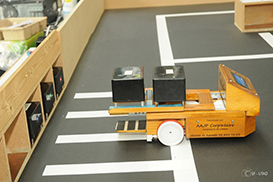

Descrição: O Robot@Factory procura recriar um problema inspirado nos desafios que um robô autónomo terá de enfrentar durante a sua utilização numa fábrica. Esta fábrica é constituída por um armazém de aprovisionamento, um armazém de produto final e oito máquinas de processamento.
O objetivo da competição é que o robô transporte caixas entre armazéns e máquinas em tempo mínimo.
As caixas têm de ser recolhidas, transportadas e depositadas corretamente pelo robô que deve ser capaz de se localizar e navegar entre obstáculos.
A competição decorrerá em três mangas que apresentam desafios de dificuldade crescente. Esta pretende ser uma prova que permita a transição gradual ao nível de complexidade e exigência técnica entre as ligas júniores e séniores, nomeadamente a condução autónoma.
Regras: http://robotica2016.ipb.pt/docs/regras-robot-factory.pdf
Rule clarification for the 2017 robot@factory edition:
As the level of the teams has increased, it has become possible to introduce elements that require more autonomy from the robots. But this should not prevent the accessibility of the competition, hindering the participation of teams with less experience. More advanced robots must be able to have some advantage, without jeopardizing the participation of simpler robots.
All machines will be operational. The machine LEDs will not be used and are switched off. In the future, some machines could be disabled permanently or temporarily.
All operations on the machines last 30 seconds. In the future, this time can be changed and/or vary from machine to machine.
In the first round all five parts are of type B. This is shown by the LED present in the box being lit with blue light. These parts can be taken immediately to the output warehouse.
Something like: | B | B | B | B | B |
In the second round there will be three parts of type B and two type G parts. Type G parts have the LED lit with green light. The type G parts must be processed in any of the available machines.
For each attempt the position of the pieces in the warehouse will vary. To soften the additional difficulty, there will be two parts whose position is already defined at the beginning. This allows a team, with no ability to distinguish the pieces, to still be able to perform some part of the challenge. The other three parts have their starting position randomly drawn.
So, in the second round a type B part will be placed in the slot that is near the corner. A type G part will be in the opposite slot.
Something like: | B | X | X | X | G |
where X means either a type B or G part. (Two of The Xs will be a type B part and one X will be a type G part)
For the second and third rounds there is an additional rule that every attempt must be spaced by at least one minute. Is only possible to resume an attempt one minute after the moment when the previous attempt was initiated. This limits the maximum number of attempts to less than 10.
In the third round, there are two type B, two type G and one type R parts. Type R Parts have the LED lit red.
The type R parts transformations into type G can only be made on the machine group nearest to the incoming warehouse and transformations of G parts into B can only be made on the machine group nearest to the outgoing warehouse.
In the third round, a type B part will be placed in the slot that is near the corner. There will only be one fixed part.
Something like: | B | X | X | X | X |
where X means either a type R, B or G part. (One of The Xs will be a type B part, two Xs will be a type G parts and one X will be a type R part)
Responsável:
Paulo Costa (FEUP), Este endereço de email está protegido contra piratas. Necessita ativar o JavaScript para o visualizar.
José Lima (IPB/INESCTEC), Este endereço de email está protegido contra piratas. Necessita ativar o JavaScript para o visualizar.


